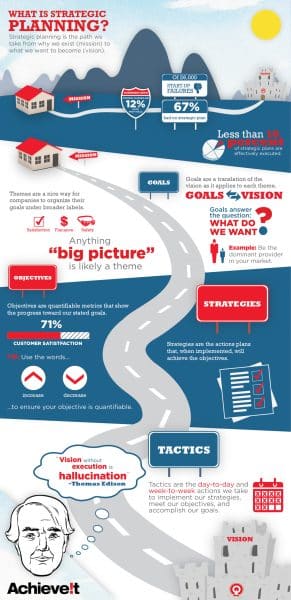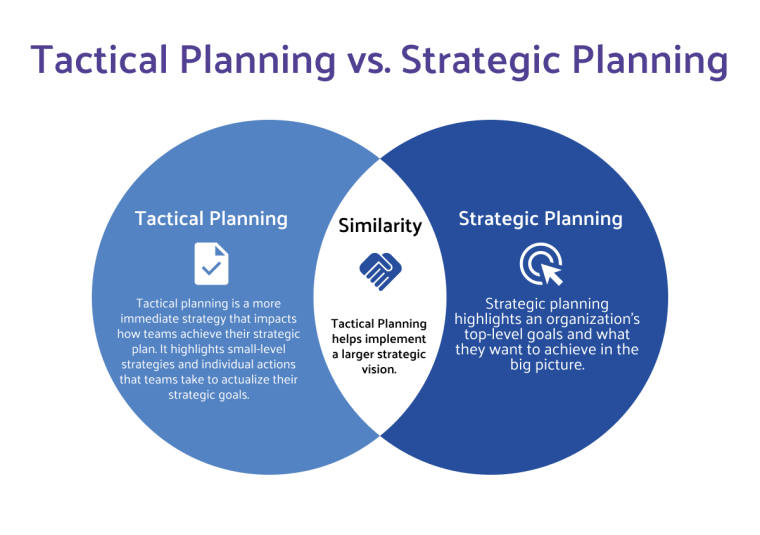Strategic planning and tactical planning are two of the most popular planning frameworks, each with its own unique use cases and applications.
Knowing the difference between these two planning approaches, as well as implementing the right one in the right place, could determine the success or failure of an organization.
This article aims to provide a comprehensive understanding of strategic vs. tactical planning, their differences, and their relevance in different situations.
Key Takeaways: Difference between Tactical and Strategic Planning
- Strategic Planning: Focuses on setting long-term goals and determining the organization’s direction over a period of three to five years or more. It involves high-level decision-making and is concerned with the organization’s overall objectives, mission, and vision. Strategic planning requires analyzing both the external environment and internal capabilities through SWOT analysis to develop strategies for growth and improvement.
- Tactical Planning: Concerned with the short-term actions and plans required to implement the strategic goals. It breaks down the strategic objectives into actionable steps, assigns resources, and sets short-term goals and deadlines. Tactical planning is more flexible and detailed, focusing on the day-to-day operations and ensuring that the strategic plan is executed effectively.
- Importance of Both: Both strategic and tactical planning are essential for an organization’s success. Strategic planning provides the vision and direction, while tactical planning focuses on execution. One without the other can lead to a lack of direction or failure to achieve goals.
- Flexibility and Responsiveness: Tactical planning offers flexibility and allows organizations to adapt to changes quickly. This adaptability is crucial for dealing with unexpected challenges and seizing opportunities in a dynamic business environment.
- Alignment and Coordination: Ensuring that tactical plans align with strategic goals is vital. This requires clear communication, coordination among teams, and regular monitoring and adjustment of plans based on performance and external changes.
- Operational Focus of Tactical Plans: Tactical plans are operational, detailing the specific tasks and activities needed to achieve the objectives. They are more focused on the “how” of execution rather than the “what” or “why” addressed by strategic planning.
What is Strategic Planning?
Strategic planning refers to the process of formulating a long-term, high-level plan to achieve an organization’s overall objectives. It involves analyzing the external environment, identifying opportunities and threats, and developing strategies to capitalize on the former and mitigate the latter.
Strategic planning provides a roadmap that shapes the organization’s direction, resource allocation, and decision-making. This form of decision-making typically represents mid to long-term goals with a life span of three to five years, though it can go longer.
Here are the key elements of strategic planning:
- Mission and Vision: Clearly define the purpose and long-term aspirations of the organization.
- Setting Objectives: Establish specific and measurable goals that support the mission and vision.
- External and Internal Analysis: Conduct a thorough analysis of the external environment, including market trends, competition, and regulatory factors. Also, assess internal capabilities, strengths, weaknesses, and resources.
- SWOT Analysis: Identify and evaluate the organization’s strengths, weaknesses, opportunities, and threats (SWOT) to uncover potential areas for improvement and growth.
- Strategy Development: Develop strategies that align with the organization’s objectives and leverage its strengths to address weaknesses, capitalize on opportunities, and mitigate threats.

How to Form a Strong Strategy
The outcome of strategic planning is a strategic plan, which should naturally lead to a strong strategy for the organization. However, it is important to note that formulating a strong strategy requires a systematic approach.
First, organizations must conduct a thorough analysis of their internal and external environments, including market trends, competition, customer preferences, and technological advancements.
Based on this assessment, organizations can identify their core competencies, unique value propositions, and areas for improvement. A strong strategy aligns the organization’s strengths with market opportunities while mitigating weaknesses and threats.
Furthermore, organizations need to regularly review and update their strategy to ensure its relevance in a changing business landscape. Every once in a while, a strategic plan may be updated and revised to reflect any strategic changes.
What is Tactical Planning?
Tactical planning, on the other hand, focuses on the implementation of the strategic plan. It involves breaking down the strategic objectives into actionable steps, setting short-term goals, allocating resources, and defining timelines.
In short, tactical planning is all about the details and specifics needed to execute the strategic plan effectively. It ensures that day-to-day operations support the strategic goals and contribute to overall success.
One major characteristic of tactical planning is its flexibility.
Unlike strategic planning, which a company cannot deviate from very easily, tactical planning is flexible and can be enhanced according to the need.
This flexibility makes tactical planning less risky, meaning that even if it goes wrong it won’t do much harm to the company.
Here are the key elements of tactical planning:
- Clear Objectives: Tactical planning starts with setting clear and specific goals and objectives. These objectives should be measurable and aligned with the overall strategic goals of the organization.
- Resource Allocation: Tactical planning involves assessing and allocating the necessary resources such as personnel, budget, time, and equipment to achieve the set objectives.
- Action Plans: Tactical planning requires the development of detailed action plans that outline the specific tasks, activities, and timelines needed to achieve the objectives.
- Coordination: Tactical planning involves assigning responsibilities and tasks to individuals or teams within the organization. It requires effective delegation and coordination to ensure that everyone understands their roles and responsibilities, and works together to achieve the common objectives.
- Alignment with strategic goals: Tactical planning must be aligned with the broader strategic goals of the organization.
What is a Tactical Plan in Business?
A tactical plan in business refers to a short-term, detailed roadmap designed to achieve specific parts of a company’s strategic plan. It bridges the gap between the company’s strategic objectives (long-term goals and vision) and the actual operational activities. Key characteristics of a tactical plan include:
- Short-Term Focus: Tactical plans typically cover a shorter time frame, often ranging from a few months to a year.
- Specific Objectives: These plans are centered around specific objectives that are aligned with the broader strategic goals of the company.
- Detailed Actions and Steps: They outline the specific actions, steps, and resources required to achieve the tactical objectives. This includes identifying tasks, assigning responsibilities, setting deadlines, and allocating resources.
- Measurable Metrics: Tactical plans often include measurable metrics or KPIs (Key Performance Indicators) to track progress and success.
- Flexibility: While tactical plans are detailed, they also allow for flexibility and adaptability to respond to short-term changes in the business environment or market.
- Operational Focus: They are more operational in nature, focusing on the day-to-day execution of tasks and activities that contribute to achieving strategic objectives.
In essence, a tactical plan translates the strategic vision and goals of a business into actionable and measurable steps, guiding teams and departments in their daily operations towards achieving these broader objectives.
How to Form a Strong Tactic?
The result of tactical planning is usually an actionable strategy or tactic for implementing the strategic plan. However, in order to develop strong tactics, it is necessary to pay close attention to detail and have a deep understanding of the organization’s resources and capabilities.
Furthermore, organizations must align their tactics with the strategic goals, ensuring that each action supports the overall strategy.
Effective tactics involve clearly defining responsibilities, establishing clear communication channels, and setting performance metrics to monitor progress.
It is also important to regularly evaluate the tactics and adjust them based on feedback and changing circumstances.
Strategic vs. Tactical Planning: What’s the Difference?

While strategic and tactical planning are interconnected, they differ in terms of scope, time frame, and level of detail. Strategic planning focuses on the big picture, long-term objectives, and major decisions that shape the organization’s future.
In contrast, tactical planning deals with the implementation of the strategic plan, concentrating on short-term goals, specific actions, and operational considerations.
Additionally, strategic planning involves top-level executives, while tactical planning involves managers and frontline employees.
Let’s dive even deeper into the difference between tactical and strategic planning.
Strategic vs. Tactical Planning: Which Is More Important?
Both strategic and tactical planning play vital roles in an organization’s success. One without the other is nearly pointless.
Strategic planning provides a vision and direction, guiding all levels of the organization toward common goals. It enables proactive decision-making, identifies growth opportunities, and ensures resource allocation aligns with priorities.
Tactical planning, on the other hand, focuses on execution, ensuring that day-to-day operations contribute to the achievement of strategic objectives. It enables effective coordination, resource utilization, and responsive actions in a dynamic environment.
The preference for strategic or tactical planning may vary depending on the situation and organizational needs.
For instance, in stable and predictable markets, strategic planning may dominate as organizations can focus on long-term goals without frequent adjustments.
However, in rapidly changing environments or during crisis situations, tactical planning becomes essential to adapt to uncertainties and seize immediate opportunities.

Strategic Goals vs Tactical Goals: The Key Differences
Strategic goals and tactical goals are two types of objectives that organizations use to plan and execute their plans, but they differ in scope, time frame, and specificity.
Let’s explore the differences between them:
Strategic Goals
- Long-term Vision: Strategic goals are long-term in nature, often spanning several years. They define the overarching aspirations of an organization.
- Broad Scope: These goals are broad and high-level, focusing on the organization’s overall direction and priorities.
- Guiding Principles: Strategic goals serve as guiding principles for decision-making throughout the organization.
- Adaptability: They may evolve as the organization’s external environment changes, such as market conditions or technological advancements.
Tactical Goals
- Short-term Focus: Tactical goals are short-term, typically focusing on a timeframe of a year or less.
- Specific and Detailed: These goals are more specific and detailed, outlining the steps needed to achieve the strategic goals.
- Operational in Nature: Tactical goals are often operational, involving the day-to-day activities of the organization.
- Measurable Outcomes: They are designed to have clear, measurable outcomes or targets to gauge progress.
In summary, while strategic goals set the direction and long-term vision of an organization, tactical goals are the specific, short-term steps taken to move towards these broader objectives.
Both are crucial for the successful operation and growth of an organization, providing a roadmap from overarching aspirations to practical, everyday actions.
Understanding Strategic vs Tactical Planning With Examples
Understanding harder to grasp topics is often easiest with familiar examples. Here are three examples to better illustrate the importance and difference of both strategic planning and tactical planning.
Example 1: Retail Business Expansion
Imagine a retail business that wants to expand its operations into new geographic markets. The strategic plan may involve conducting market research, identifying target locations, and developing a marketing strategy to penetrate those markets.
Meanwhile, in this case, tactical plans would include designing the store layout, product assortment, pricing, and promotional tactics specific to each location.
The strategic plan sets the overall direction, while the tactical plan ensures effective execution and adaptation to local market nuances.
Example 2: Product Launch

For a company launching a new product, the strategic plan may include identifying the target market, conducting a competitive analysis, and developing a unique value proposition.
In contrast, the tactical plan would focus on product design, production processes, distribution channels, pricing strategies, and marketing campaigns.
While the strategic plan oversees the long-term success of the product, the tactical plan ensures the timely and efficient rollout of the product in the market.
Example 3: Crisis Management
During a crisis, such as a natural disaster or a sudden economic downturn, strategic and tactical planning are both crucial. The strategic plan may involve evaluating the impact, assessing risks, and developing contingencies to ensure business continuity.
On the contrary, the tactical plan would focus on short-term actions, such as mobilizing resources, reallocating budgets, and communicating with stakeholders.
However, in order for the organization to navigate the crisis effectively and minimize potential damage, it would need to implement both strategic and tactical planning together.
The Bottom Line
Now you the difference between strategic vs. tactical planning.
In summary, strategic planning establishes the direction and long-term goals of an organization, while tactical planning focuses on the implementation and short-term actions that support the strategic objectives.
It is crucial to note that both planning approaches are valuable and necessary for success, and their importance may vary depending on the specific circumstances faced by an organization.
The winning strategy in effective planning is to strike a balance between strategic and tactical planning.
This way, the organizations can adapt to the ever-changing business landscape, capitalize on opportunities, and achieve their desired outcomes.
References:
